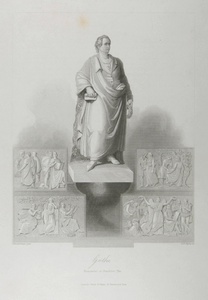| Method | Steel engraving |
| Artist | Albert Henry Payne after Ludwig Schwanthaler |
| Published | London: Brain & Payne, 12, Paternoster Row [c.1850] |
| Dimensions | Image 184 x 157 mm, Sheet 274 x 208 mm |
| Notes |
Johann Wolfgang von Goethe (28th August 1749 - 22nd March 1832) was a German writer, statesman, and polymath. Although best known for Faust and The Sorrows of Young Werther, Goethe also wrote works on literary criticism, aesthetics, philosophy, botany, anatomy, and prose and verse of all genres. He was one of the leading authors of the German Sturm und Drang (Storm and Stress) literary movement, and, later in life, a founding figure of Weimar Classicism. Goethe's relationship with Romanticism was tumultuous. Although he is often identified as a key member of the German Romantic movement, in later life, Goethe vehemently distanced himself from Romanticism, seeing it as inferior both philosophically and emotionally to the humanist aims of Weimar Classicism. Despite this personal disavowal, Goethe was a key source of inspiration for the British Romantics. His first novel, The Sorrows of Young Werther, was written when Goethe was only 24, and immediately elevated him to international fame. The titular protagonist, Werther, is a delicate, melancholic, and intellectual young man, caught in a destructive love-triangle with the beautiful peasant girl Lotte and her older fiancé Albert. Unable to satisfy his love for Lotte, and unwilling to destroy Albert, Werther decides upon his own dramatic suicide. The demise of the talented, emotional, and tragic young Werther became emblematic of the real lives of many of the Romantic poets, sharing particularly close parallels with the supposed suicide of the young Thomas Chatterton, author of the gothic Rowley poems. The publication of The Sorrows of Young Werther even inspired a popular fashion amongst young men of the time, who began to ape Werther's style of dress, his moody and intellectual demeanour, and even in extreme cases his suicide. Goethe's play Faust is widely considered to be a high point of German literature. Based on German folk myths about a Doctor who makes a pact with the Devil in exchange for knowledge and worldly pleasures, the play shared many similarities with other works of gothic romanticism, including Beckford's Vathek and Mary Shelley's Frankenstein, and was translated, at least in part, by both Coleridge and Percy Shelley. This steel engraving is based on the sculpture of Goethe by Ludwig Schwanthaler, from the Goethe Memorial in Frankfurt. The author is depicted wearing the same heavy travellers cloak as in the famous portrait painted of him during his Italian Journey, though here he is standing rather than supine. His left arm rests on a tree trunk festooned with grapes, and he carries a scroll in his left hand. In his right he holds a laurel wreath, a symbol of poetic victory. The pillar on which the sculpture stands is surrounded by bas reliefs depicting the victory of the Muses, and scenes of Germanic pastoral life. Albert Henry Payne (14th December 1812 - 7th May 1902) was a British engraver, printmaker, and illustrator, who spent the majority of his life in Leipzig, Germany. Ludwig Michael Schwanthaler (26th August 1802 - 14th November 1848) was a German sculptor and lecturer at the Munich Academy of Fine Arts. He is best known for the Mozart memorial in Salzburg and the Goethe memorial in Frankfurt. Condition: Very light foxing, not affecting image. |
| Framing | unmounted |
| Price | £15.00 |
| Stock ID | 36344 |

